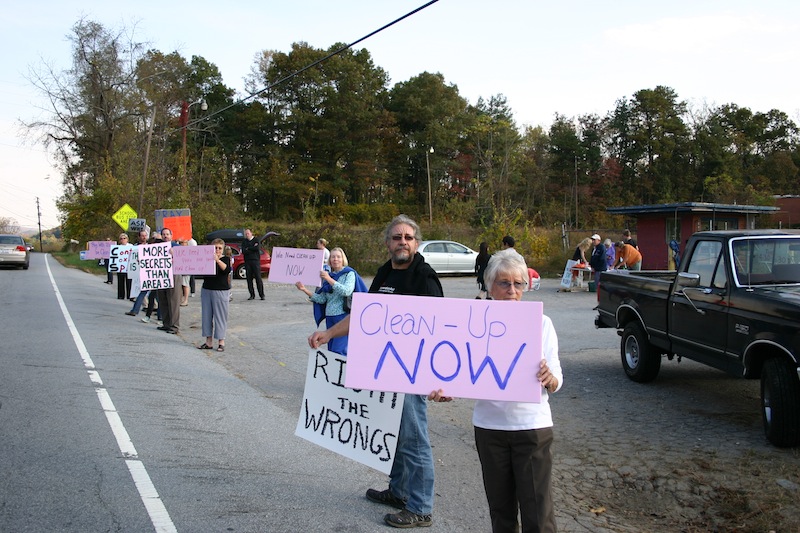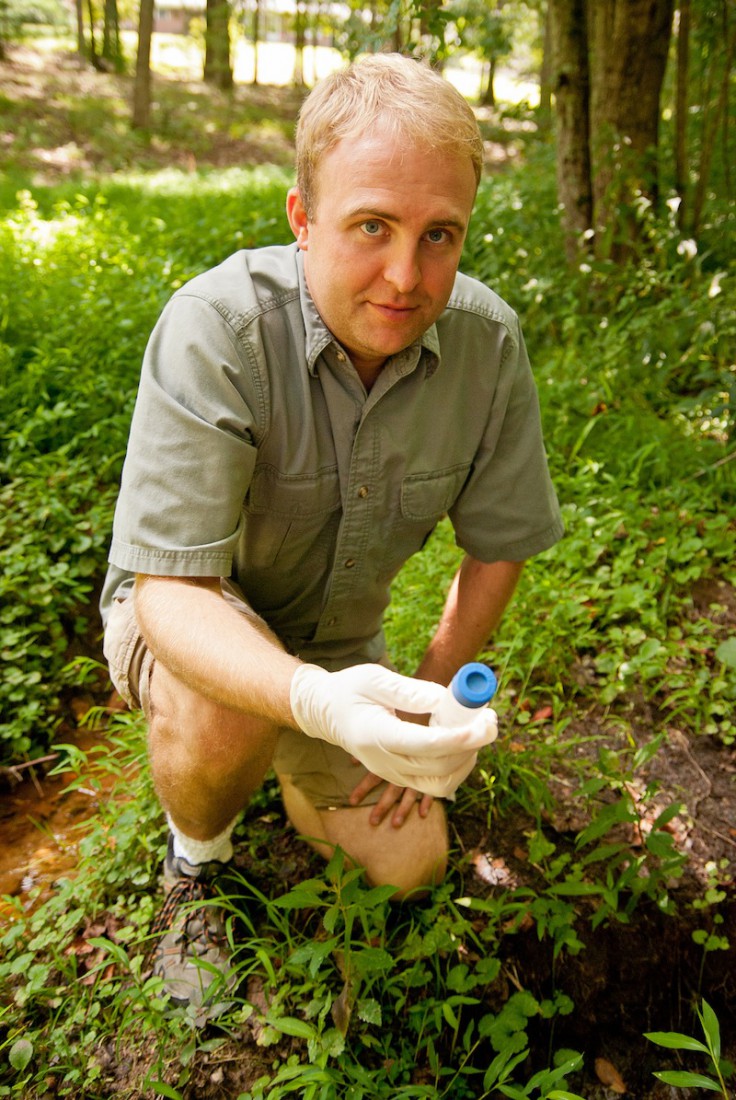Editor’s note: Five years after Xpress broke the news of severe contamination at the former CTS plant in south Asheville (see “Fail-Safe?” July 11, 2007, Xpress) the story is far from over. The property was officially designated a Superfund site this year, and tests last month showed high levels of toxic chemicals still leaching from it.
A locked fence surrounds the little wetland on the Rice family’s property on Mills Gap Road; signs warn the curious away. To date, the U.S. Environmental Protection Agency has spent millions of dollars on the problem, billing the company for the costs of testing, emergency water supplies for affected residents and a soil-vapor-extraction system intended to remove hazardous chemicals from surface soils around the former plant. But the full cleanup neighbors have demanded for years hasn’t even been designed yet, let alone begun.
And independent testing conducted last month by UNCA hydrogeologist Jeff Wilcox found trichloroethylene, a chemical degreaser used at the plant, at 11,000 parts per billion in the Rices’ springs — thousands of times the 5 ppb legal limit for human contact.
Lockheed Martin, an EPA contractor, had identified the probable source of that contamination in 2001: a plume of concentrated TCE measuring as high as 830,000 ppb, sitting in a trough in the bedrock some 30 feet below the former plant’s plating room. After various delays, CTS hired AMEC, a London-based company with an Asheville office, to conduct a remediation study in response to a 2004 agreement with the EPA.
“This thing is dripping with TCE,” a known carcinogen, Wilcox exclaims, studying a cross-section diagram. “It’s off the chart: The machines that analyze it can’t read that high. You have to dilute it 10,000 times just to analyze it.”
Neighborhood resident Dave Ogren says he called the state Department of Environment and Natural Resources way back in 1987 to report an open chemical pond at the recently shuttered plant. But it wasn’t until 1990 that an EPA contractor collected a sample from the Rices’ springs, without their knowledge. And though tests revealed high levels of TCE, the contractor recommended no further action, the family wasn’t informed — and they continued drinking and bathing in that toxic water for another nine years.
The EPA did provide hookups to city water for the Rices and their neighbors, the Robinsons, in 1999, after a staffer at the state agency called the EPA’s Atlanta office to report contamination in both families’ drinking-water sources.
“We recognized quickly that we had a source of contamination that was getting into a fractured-bedrock aquifer that threatened people’s drinking water,” says Don Rigger, who took that call. Rigger is now chief of the Atlanta office’s Superfund Branch.
Meanwhile, Mills Gap residents have endured a steady stream of health problems, including cancers, immune disorders and early deaths.
Silent springs
The vapor-extraction system AMEC installed at the plant in 2006 sucked 3 tons of volatile organic compounds from surface soil before it was wrecked by vandals in 2010; it was never repaired. But in any case, Wilcox explains, “It didn’t address this [underground source] at all.”
In a taped interview conducted by Mills Gap resident Tate MacQueen (http://avl.mx/jr), former CTS employee Jean Harding described how employees dumped chemical waste from the plant’s electroplating process into an improvised drainage system in the ground. From there it spread to soil, groundwater and nearby Dingle Creek.
Based on the amount of TCE now present in the Rices’ spring, Wilcox, who specializes in contamination hydrology, estimates that hundreds, perhaps thousands of 55-gallon barrels of toxic chemicals were dumped at the CTS site. The company did not return phone calls seeking comment.
The underlying geology, he says, provides a likely explanation for the continuing high levels of TCE in both the Rices’ springs and a well in The Oaks subdivision, a mile from the CTS site. Mills Gap Road, he notes, sits atop a geologic fault that delivers surface and groundwater to the east. Fissures in the bedrock under Pinner’s Cove Road funnel groundwater north.
“TCE is hydrophobic,” Wilcox explains — it doesn’t mix with water — “and it’s heavier than water, so it sinks and pools into any available crevice it can find.” Thus, it might not be evident until a change in underground flow patterns begins picking it up bit by bit and, eventually, it shows up in a seep or spring or someone’s well.
Thanks to some cutting-edge toxicological studies, Wilcox and his students have even found TCE in the tissues of trees growing near the contaminated springs.
Meanwhile, the EPA says it’s nearly ready to begin defining the scope of the problem and mapping out a final solution to address the subterranean hazard. Last month, agency officials met with residents from households in the immediate area that are still on well or spring water. About 80 households have accepted whole-house filters offered as part of a remediation agreement the EPA and CTS signed earlier this year. Installation of the customized filtration systems began Sept. 11.
“The actions that we’re taking — the quarterly monitoring, the house filters — we’re comfortable that we are addressing the risk in an appropriate manner,” says Rigger.
But that doesn’t play well with the beleaguered Mills Gap residents. “We understood when we signed that easement agreement they were coming on here to clean up,” says Dot Rice. “And they never have.” Meanwhile, she reports, rare cancers and other health problems have plagued her family, their property’s value has tanked, and the EPA just continues investigations that never seem to lead to a cleanup.
“We’ve got 38 monitoring wells on our property — and most of the time, they don’t even give us the results,” Rice reports. After EPA testing in March revealed 10,000 ppb — and, once again, the Rices weren’t notified, she says — “I wrote them a letter saying I don’t want them on my property. If they do something worthwhile, I will be glad to let them on. But to keep coming on, testing all the time, I’m tired of it.”
Extra effort
To date, notes Rigger, “A lot of money’s been spent by both EPA and CTS — more than is typical.” And the things that money has paid for — the city-water hookups, the filters and the vapor-extraction system, plus the work needed to place the site on the National Priorities List and all the interfacing with the community — amount to more attention than many Superfund sites get.
“I’m not going to apologize for that,” he continues. “I think it’s a good thing, the best chance [we have] to get a thorough investigation and a thorough cleanup.”

But remedial investigations typically take years, agency staffers note. “EPA, CTS and community members know that a deeper investigation is needed,” says Samantha Urquhart-Foster, the agency’s remedial-project manager. The 2004 agreement with CTS, she explains, called for two separate work plans: one for shallow soils and another for underlying contamination down to the bedrock, both at the plant site and on adjacent property.
To define the size of the cleanup area, new samples must be collected, she reveals. And because expensive, specialized equipment is needed for both plans, the EPA agreed to let CTS postpone the first study until the work plan for the second, deeper investigation is approved, so the work can be done concurrently.
The EPA is working with AMEC to finalize the combined work plan, Urquhart-Foster reports. “Sampling will be scheduled after the work plan is approved and access authorizations are received from adjacent property owners.”
But there’s no guarantee that the Rices will allow that access. Meanwhile, neighbor Shannon Robinson was diagnosed with thyroid cancer earlier this year.
Cleaning up the mother lode of contamination will be costly, notes Wilcox, but it’s essential to protect both the environment and area residents. Specially trained workers, he says, could mechanically scoop out and haul off the plume of TCE for proper disposal; extractors can pump and treat contaminated soils.
Wilcox says he admires the Mills Gap residents’ fortitude, especially those key players who’ve spent countless hours untangling and documenting a complex, highly technical case.
“I’m amazed at the number of people who have been affected by this who still say, ‘I just want it cleaned up,’” he observes. “They don’t say, ‘I want them to pay through the nose’ — they just want it cleaned up.
“And the entity that can clean this up the fastest is CTS. They could do it tomorrow.”
Freelance writer Susan Andrew lives in Asheville. To view a timeline of the CTS case, go to http://www.timetoast.com/timelines/cts-contamination. For more history, visit http://www.mountainx.com/xpressfiles/040908ctssite. For the latest CTS-related articles, check http://www.mountainx.com/tag/cts.



Before you comment
The comments section is here to provide a platform for civil dialogue on the issues we face together as a local community. Xpress is committed to offering this platform for all voices, but when the tone of the discussion gets nasty or strays off topic, we believe many people choose not to participate. Xpress editors are determined to moderate comments to ensure a constructive interchange is maintained. All comments judged not to be in keeping with the spirit of civil discourse will be removed and repeat violators will be banned. See here for our terms of service. Thank you for being part of this effort to promote respectful discussion.